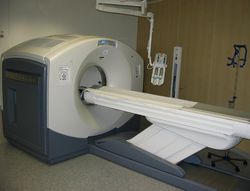Antimatter fuel
Antimatter, when it comes into contact with regular matter, releases a huge amount of energy. This energy is in the form of an explosion. This explosion can be harnessed for electrical means (Creating electricity) or as a thrust (Because antimatter has to be created, it would be extremely inefficient to use for electricity.) Since newtons laws state that if you push something, you get pushed. That is how rockets work. The antimatter can be exploded and forced behind the rocket, pushing the rocket forward. But antimatter reactions can produce harmful discharges of high energy gamma rays. High energy gamma rays break down molecules in cells and can also make the rocket engines radioactive.[1] The National Aeronautics and Space Administration (NASA) is currently doing research to reduce this harmful side effect.[1]
Antimatter Fuel Media
A cloud chamber photograph of the first observed positron, 2 August 1932.
References
- ↑ 1.0 1.1 "Bill Steigerwald". NASA. 14 April 2006. Retrieved 21 April 2014.

